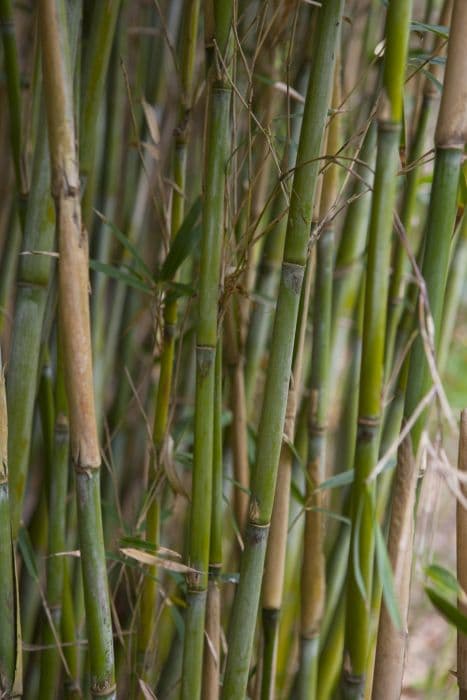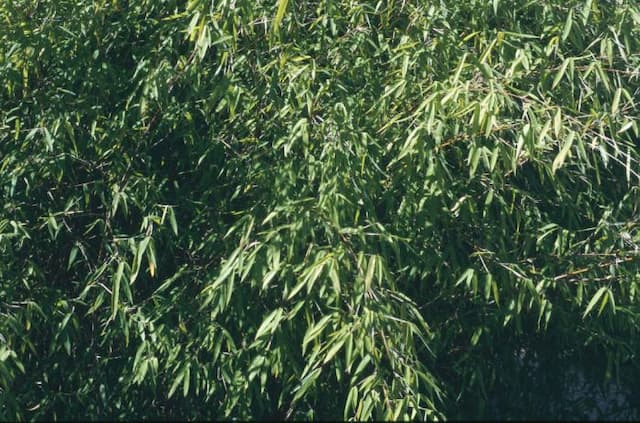Quaking grass Briza media 'Russells' (PBR)











ABOUT
Briza media 'Russells' (PBR), commonly known as quaking grass, features a characteristic clump-forming habit with a plethora of elegant, nodding flowerheads. The foliage is typically fine-textured, offering a soft and airy appearance. The slender leaves emerge in a luscious green shade, contributing to the delicate verdure of the grass. During the flowering season, quaking grass produces petite, heart-shaped florets that dangle from slender stalks. These florets are particularly charming as they dance and tremble in the slightest breeze, which is how the plant garnered its evocative common name. The flowers exhibit a soft hue, which might range from a light beige to gentle tones of purple or green, adding a subtle color variation that makes the plant an intriguing visual specimen in gardens or as part of naturalistic landscaping. After the bloom, the plant might produce seed heads that retain ornamental interest, often taking on a more straw-like color as the season progresses. The texture and fluid movement of the plant make it a favorite for creating a sense of motion in a garden setting, and it is recognized for its ability to catch both light and shadow, casting delicate silhouettes that can enhance the garden's aesthetic throughout the day.
About this plant
 Names
NamesFamily
Poaceae.
Synonyms
Quaking Grass, Cow Quake, Doddering Dillies, Shaking Grass.
Common names
Briza media 'Russells' (PBR)
 Characteristics
CharacteristicsLife cycle
Perennials
Foliage type
Deciduous
Color of leaves
Green
Flower color
Varies
Height
2 feet (60 cm)
Spread
1 foot (30 cm)
Plant type
Grass
Hardiness zones
5
Native area
Europe
Benefits
 General Benefits
General Benefits- Attractive Ornamental Features: Briza media 'Russells', commonly known as Quaking Grass, has unique, pendulous flower heads that gracefully quiver and rustle in the breeze, adding movement and texture to gardens.
- Low Maintenance: This plant is relatively low maintenance, requiring minimal care once established, making it ideal for gardeners seeking easy-to-maintain landscapes.
- Drought Tolerant: Quaking Grass is able to withstand periods of dryness once it is established, making it suitable for drought-prone areas and water-wise gardens.
- Wildlife Friendly: The seeds of the Quaking Grass are a source of food for birds, and its presence in the garden can help attract and support wildlife.
- Adaptable to Various Soils: The plant is adaptable to a wide range of soil conditions, which makes it versatile for use in different garden settings.
- Seasonal Interest: Briza media 'Russells' offers visual interest throughout multiple seasons, with its attractive foliage and later in the season, its noteworthy seedheads.
- Compatibility with Other Plants: Quaking Grass works well when planted in conjunction with other perennial plants, creating a mixed border or meadow-like appearance.
- Non-Invasive: Unlike some ornamental grasses, Quaking Grass is not invasive, ensuring that it won't outcompete other plants in the garden.
 Medical Properties
Medical PropertiesThis plant is not used for medical purposes.
 Air-purifying Qualities
Air-purifying QualitiesThis plant is not specifically known for air purifying qualities.
 Other Uses
Other Uses- Art and Craft Supplies: The elegant seed heads of Quaking grass are often dried and used in floral arrangements, wreaths, and other decorative art projects.
- Educational Specimens: Botany students and educators can use Quaking grass to examine and teach grass structure and seed dispersal methods.
- Sound Effects in Theater: The rustling sound of the dried seed heads can be used in theatrical productions to mimic sounds of nature like rustling leaves or crops in the wind.
- Photography: Quaking grass is often used as a subject or backdrop in macro and nature photography for its aesthetic appeal.
- Landscape Design: Quaking grass is used in landscape design for its movement and texture, which can add a whimsical element to gardens and parks.
- Erosion Control: It can be planted on slopes or areas prone to erosion to help stabilize the soil with its root system.
- Livestock Fodder: While not a primary choice, Quaking grass can be grazed by livestock, especially when other forage is scarce.
- Roof Thatching: In historical and specialized modern applications, Quaking grass has been used for roof thatching due to its durable and insulating properties.
- Biodegradable Packing Material: Dried seed heads can be used as a natural, biodegradable packing material to cushion fragile goods.
- Traditional Celebrations: In some cultures, Quaking grass is used in festivals and ceremonies, symbolizing agricultural abundance and heritage.
Interesting Facts
 Feng Shui
Feng ShuiQuaking Grass is not used in Feng Shui practice.
 Zodiac Sign Compitability
Zodiac Sign CompitabilityQuaking Grass is not used in astrology practice.
 Plant Symbolism
Plant Symbolism- Peace: Briza media, commonly known as Quaking Grass, produces gentle, nodding flower heads that evoke a sense of calm and tranquility, hence symbolizing peace.
- Harmony: The way the seed heads of Quaking Grass move in unison with the breeze can symbolize harmony with nature and the environment.
- Flexibility: Quaking Grass is flexible and bends easily without breaking, often symbolizing adaptability and resilience in the face of change.
 Water
WaterQuaking grass should be watered moderately, ensuring the soil is kept moist but not waterlogged. During the active growing season in spring and summer, watering may be required once or twice a week, depending on the weather conditions and soil drainage. It's preferable to water deeply, allowing water to reach the roots – for a potted plant, this could be about half a gallon every week. In the dormant season, fall and winter, reduce watering frequency to once every two weeks or less, depending on the climate. Overwatering can lead to root rot, so it's important to let the soil dry out slightly between watering sessions.
 Light
LightQuaking grass thrives best in full to partial sun exposure. This means it should receive at least 4 to 6 hours of direct sunlight per day. The ideal spot for this plant would be an area where it gets morning sunlight and some shade in the afternoon to protect it from the intense heat of midday, especially in hotter climates.
 Temperature
TemperatureQuaking grass prefers temperate conditions and can typically withstand temperatures as low as 20 degrees Fahrenheit and as high as 80 degrees Fahrenheit. Optimal growing temperatures are between 60 and 75 degrees Fahrenheit. Extreme temperatures outside of this range, especially prolonged freezing or sweltering heat, can damage the plant.
 Pruning
PruningQuaking grass doesn't require frequent pruning, but it can be beneficial to trim back the plant after flowering to maintain its shape and encourage new growth the following season. Prune in late winter or early spring before new growth begins. Remove dead or damaged foliage as needed to keep the plant looking tidy.
 Cleaning
CleaningAs needed
 Soil
SoilQuaking Grass prefers well-draining soil with a pH ranging from 6.0 to 7.5. A mix of loam, sand, and compost is ideal to provide the necessary nutrients and drainage.
 Repotting
RepottingQuaking Grass is typically grown as a perennial and does not require frequent repotting. It should be repotted every 2 to 3 years to refresh the soil.
 Humidity & Misting
Humidity & MistingQuaking Grass thrives in average humidity levels found in most outdoor environments and does not have specific humidity requirements.
 Suitable locations
Suitable locationsIndoor
Place Quaking Grass in bright, indirect light indoors.
Outdoor
Plant Quaking Grass in full sun to partial shade outdoors.
Hardiness zone
4-9 USDA
 Life cycle
Life cycleBriza media 'Russells' (PBR), commonly known as Quaking Grass, starts its life cycle as a seed, which requires sowing in well-drained soil during spring or autumn. The seeds germinate, and seedlings emerge, usually requiring a cold period to break dormancy. After germination, the plant grows into a clump of grass with narrow leaves, entering the vegetative stage. During late spring to summer, Briza media 'Russells' (PBR) reaches the reproductive stage, developing flower stalks and panicles with dangling spikelets that quiver in the wind. After pollination, which is mainly by the wind, the flowers develop into seeds that mature by late summer. The plant then enters a period of dormancy during winter, when growth slows down, completing its annual life cycle to start anew with the next generation of seedlings in the following spring.
 Propogation
PropogationPropogation time
Spring-Early Summer
Briza media 'Russells' (PBR), commonly known as Quaking Grass, can typically be propagated by seed. The best time to sow the seeds is in the spring, after the risk of frost has passed and the soil has begun to warm up. To propagate by seed, one must prepare a well-draining potting mix in a flat or container. Sow the seeds on the surface of the soil, lightly pressing them into the soil without completely covering them, as they need light to germinate. Keep the potting mix moist but not waterlogged. Seeds will usually germinate within two to three weeks when maintained at around 70°F (21°C). When seedlings are large enough to handle, they can be transplanted to their final position, preferably in a sunny or partly shaded area with well-drained soil.









